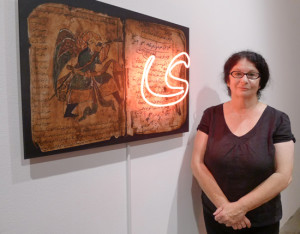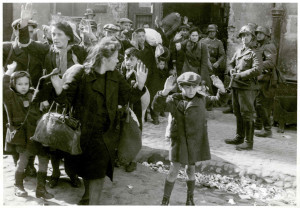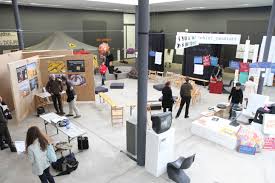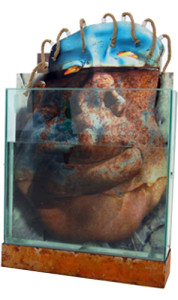The twin exhibitions — “Counterculture” and “Cultural Economies” — inaguarated what is certain to be a contentious re-evaluation of the alternative and activist cultural practices that emerged in the mid-1960s and reached a zenith in the mid-1980s. Ambitious in scope, these paired presentations responded to a request by the New York State Council on the Arts to “evaluate and assess the alternative arts movement, its history, and the contributions made by individuals and institutions within the movement to the field of contemporary art.”
The reach of these exhibits was impressive, especially when one considers how the Council’s appeal might have been answered by a requisite narrative commemorating alternative spaces as a proving ground for today’s successful artists. Instead, what Julie Ault at the Drawing Center, and Brian Wallis and Melissa Rachleff at Exit Art, spread before the viewer was the material residue of a relentless, if heterogeneous assault by the New Left and by artists on the culture and politics of the United States during the last thirty years.
A foray into this agglomeration took one past documents, communiques, posters, art objects, `zines, newspapers, journals, web pages and came to a predictable halt at that particular branch of the consciousness/entertainment industry known as the art world. And it was in this familiar space that conceptual shortcomings appeared. Despite hinting at an essential link between the cultural revolution of the 1960s and the anti-Greenbergian “political” art of the late 1970s, the viewer was left to guess the nature of this historical reciprocity. Keeping pace with current intellectual style, the curators eschewed systematic analysis, opting for what Ault described as “no complete story, no real story, no decisive reading of events or their meanings,” and in the case of “Counterculture,” this anti-totalizing approach led to sets of discrete thematic classifications with no connective ligature. Paradoxically, these attempts to outmaneuver the defiles of an overarching, “master narrative” opened the door to a less savory exegesis. While ostensibly presenting the triumphs of a now waning “age of alternative art,” the political indecisiveness of each display betrayed the lowered critical expectations and dreary resignation before the market hegemony that characterizes the art world of the 1990s.
“Counterculture” immediately alluded to Rodchenko’s constructivist Worker’s Club reading room of 1925. Plastic-covered plywood counters encircled the gallery’s two rooms, encapsulating hundreds of printed artifacts from the 1960s underground to the NEA-sponsored political art of the early nineties. Documents from the 1964 Free Speech Movement at Berkeley and the Columbia University Strike in 1968 initiated the exhibition. Spread across shelves and upon walls were copies of the Berkeley Barb, the East Village Eye, and the San Francisco Oracle. Together, they announced the leitmotif of the sixties: revolt and self-realization. But nostalgia mixed with estrangement as recent battles over indecency, censorship and societal diversity begin to seem like footnotes to the all-out political and cultural war that was the 1960s.
Exit Art’s large, back space contained posters and printed artifacts from the New York art scene of the late seventies to the early nineties including work from the Art Workers Coalition (AWC), Artists Meeting for Cultural Change (AMCC), Colab, REPOhistory, ACT-UP and the Lesbian Avengers. A text panel titled “Artworkers and the Culture Wars” introduced this space. If the first room manifested a history still being sorted out, the second room displayed the ways this material was taken-up by the circumscribed language of the art world.
But why “Culture Wars”? This appellation ushers us off the “streets” and into the symposia and conferences of academia. If the “war at home” once helped bring the U.S. military to its knees, the “Culture Wars” are described as a “contestation over what forms of expression are deemed acceptable in American society.” Somewhere between room A and room B, a battle that once raged beneath the banner of revolution dwindled to a debate over curriculum. By contrast there is nothing equivocal about most of the work presented in this room. Take as just one example artifacts from “The Real Estate Show.” In December 1979, members of Collaborative Projects, one of the first artists groups to combine a self-conscious, neobohemian sensibility with postpunk, anarchist politics, broke into an abandoned city-owned storefront to install an exhibit denouncing New York’s draconian housing policies on the Lower East Side.
Significantly, the hinge between the radical ebullition of the sixties and the “political art” of the eighties was effected through the 1970s punk subculture. An assortment of micro-publications known as ‘zines, with titles like Raw, Slash, Creep, ZERO and Sick Teen, were papered from floor to ceiling in the narrow corridor just outside the gift shop. To question why this visually fascinating, though nihilistic, subculture was chosen as the figurative and literal route from sixties radicals to the eighties art world takes us to the heart of the exhibition’s implicit argument. If the emergence of a punk aesthetic in cyberspace offers credibility for the rhetorical position of the ‘zines, it also exposed the degree to which the show’s logic argued backwards from the retrenched politics of the present.
Instead of drawing one tangent from Woodstock to ‘zines to the Internet, the curators might have displayed the Anti-Catalog, Left Curve, UpFront, Heresies or The Fox — all publications that slammed, however naively at times, the cynical, retro-politics of the 1970s and 1980s art world in a way that looped back to the street-politics of the 1960s. To do this would have implied that not all of these so-called “Culture Wars” have been, or are, being waged within the narrow theater of the art world or on digital display technology.
One difficulty “Counterculture” presented to viewers was its paucity of detailed wall labels. This, in conjunction with the impossibility of opening and paging through key artifacts, made piecing together the continuity of the show extremely difficult for anyone not familiar with these histories. For those more knowledgeable, the absence of a larger social/historical framework left key questions unspoken. One would be why the cultural revolution of the 1960s occurred when income in the United States was better distributed between the classes than it had been before or since. Another question is why the outbreak of politically conscious art fifteen years later occurred during the anti-Keynesian, anti-working class assault of the Reagan administration. Were artists catching up with this cultural shift by abandoning formalism for content-based art? “Counterculture” provided the evidence but not the critical tools needed to pursue such inquiries.
“Cultural Economies” was smaller, less densely packed, and more clearly a personal curatorial statement than “Counterculture.” Curated by Julie Ault, a co-founder of the political art collective Group Material, “Cultural Economies” offered surprises and unexpected pleasures. One example was the seldom seen sculpture of Rebecca Howland, whose spliced-together cartoon-like animals and pint-sized World Trade Center pithily satires city housing policies. Once located atop the Williamsburg Bridge, Ault justifiably made it the centerpiece.
As with “Counterculture,” the show offered little historical direction. From the wall labels one learned more about which gallery now represents each artist than the context in which the alternative space or activist artifact first appeared. The shortage of explanatory notes follows logically from a show framed as “not a history, not a polemic, not a comprehensive, not a chronology.” And certainly this list could include the alternative spaces and art collectives not represented here, like the Taller Boricua, Bullit Space, the Basement Workshop, Godzilla, the Organization of Independent Artists, Epoxy, Artists for Nuclear Disarmament, the Alliance for Cultural Democracy, or the Alternative Museum (the last being one of the first “oppositional” art spaces of its kind). One reason for these oversights, I understand, was the difficulty of collecting material from so many disparate sources. In fact most of the archival posters and documents in “Cultural Economies” were borrowed from the PAD/D (Political Art Documentation/Distribution) archives at the Museum of Modern Art.
one-day event with art components
Still, while Helene Wiener, the director of Artist’s Space during the infamous “Nigger Drawing” episode, and later the founder of Metro Pictures, was conspicuous for an exhibit she curated extolling the new East Village galleries of the 1980s, PAD/D, a vehement challenger to the art world’s role in gentrifying that neighborhood, was represented on a table as supplementary reading material. PAD/D’s absence from the more focused viewing spaces may have been due to the group’s distance from the jolly art world of the 1980s. PAD/D was less concerned with the cultural economy of SoHo than with a Sisyphean effort to organize artists into a kind of left cultural block. Like AMCC and AWC before it, PAD/D produced little in the way of displayable “art objects.”
This was where the singular presentation of art, documents and artifacts was most troubling. Turning a blind eye to its own cultural economy, the exhibition’s focus on collectibles tended to reinstate the very connoisseurship that many of these alternative voices once defined themselves against. The passion, even bile, of so much of this history, drained away by visual civility, reduced “Cultural Economies” to a smart-looking “art show” from the season of 1996.
Maybe such aestheticized displays are necessary to engage younger artists, to move them to challenge the “business as usual” art world of the nineties. But I would argue that if the material presented here is to be honoured, then one is obliged to shout, to polemicize, and in short to be as strident and as angry as the work itself. The curators of both projects have made clear their intentions to publish more thoroughly researched histories. Ault has indicated she plans to produce a series of traveling exhibitions using this material. Looking forward to those future projects, “Counterculture” and “Cultural Economies” are important not only for the vast material they brought together but for the lessons generated by their limitations, as well as for the promises they now set in motion.






